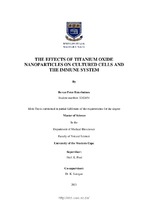| dc.contributor.advisor | Pool, Edmund | |
| dc.contributor.author | Esterhuizen, Bevan Peter | |
| dc.date.accessioned | 2021-09-06T11:43:56Z | |
| dc.date.available | 2021-09-06T11:43:56Z | |
| dc.date.issued | 2021 | |
| dc.identifier.uri | http://hdl.handle.net/11394/8428 | |
| dc.description | >Magister Scientiae - MSc | en_US |
| dc.description.abstract | Engineered nanomaterials derived from various bulk materials are being developed in ever larger quantities and with very diverse chemical compositions. The physical and chemical properties of the smaller nanoparticles are very different compared to their larger bulk chemicals. Titanium dioxide nanoparticles (TiO2NPs) are an example of such an engineered nanomaterial. Titanium dioxide nanoparticles are mainly used as a pigment in many applications such as glazes, enamels, plastics, pharmaceuticals, cosmetics, and it is widely used in sunscreens. Human exposure to TiO2NPs can occur both during manufacturing and use. | en_US |
| dc.language.iso | en | en_US |
| dc.publisher | University of Western Cape | en_US |
| dc.subject | Titanium dioxide nanoparticles | en_US |
| dc.subject | Chlorpromazine | en_US |
| dc.subject | Immune system | en_US |
| dc.subject | Cellular parameters | en_US |
| dc.subject | Human exposure | en_US |
| dc.title | The effects of titanium oxide nanoparticles on cultured cells and the immune system | en_US |
| dc.rights.holder | University of Western Cape | en_US |

